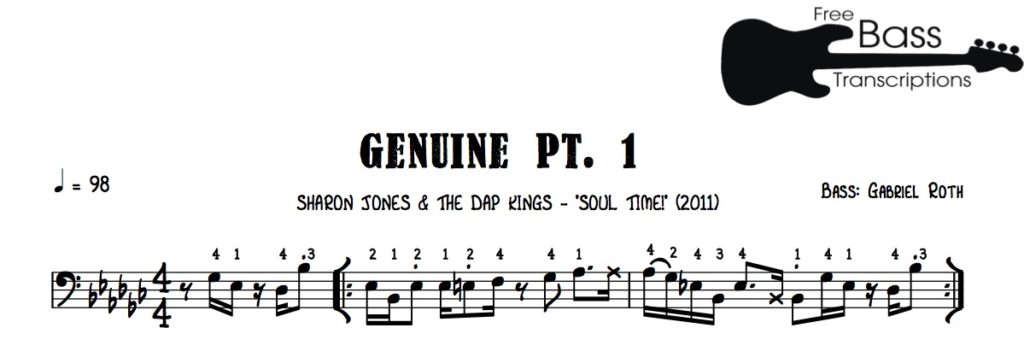Before we get into the groove, so to speak, I want you to make the following promise to yourself: “I will set aside 104 minutes of my life to watch ‘Miss Sharon Jones!‘”
(It’s even on Netflix; it’ll make a nice change from binge-watching Mad Men.)
Gabe Roth’s rock-solid groove on ‘Genuine Pt. 1’ is one of my favourite lines in this series; he somehow manages to weave together chromatic movement, wide interval jumps and head-nodding syncopated rhythms to form an instantly hummable bass part that had me immediately thinking ‘what was that?’.
From the video you can see that the line doesn’t exactly sit in one position or fit under the fingers particularly comfortably – I tried all of the logical fingering options (and even a few illogical ones) until I arrived at the following approach, which I feel is the best compromise between consistency of tone and ease of playing:
May The 4ths Be With You
Sorry, I couldn’t resist the pun.
The first interval in the repeated section of the line is a perfect 4th (Eb to Bb and back again), which is one of the most common and most awkward things to do on a stringed instrument tuned in 4ths – you’re transitioning between the different strings but staying on the same fret, so there are three sensible options when it comes to the left hand:
- Use two different fingers (as per the above example). This allows maximum control over the note lengths, so is the most preferable approach, although it might not be practical in other contexts.
- ‘Roll’ between the two notes using the same finger. This is handy when option 1 isn’t possible, but it’s easy to let the notes ‘bleed’ into one another or to pull on the string while rolling, making the second note slightly sharp.
- Jump between the two notes using a single finger. This avoids the over-ringing and intonation issues of option 2, but it takes considerable practice to be able to maintain full note lengths while doing this and jump strings without an audible gap.
In an ideal world, we’d spend equal amounts of time working on each approach, but that’s not particularly realistic. Thankfully, the more music you encounter the easier it becomes to intuitively know which approach is best for the line that you’re playing.
Other instruments have a much easier time when it comes to playing 4ths – beware of saxophonists and keyboard players who thrive on writing hellish, 4th-ridden melodies like ‘Freedom Jazz Dance’:
https://www.youtube.com/watch?v=kf7FB4ilX5w


